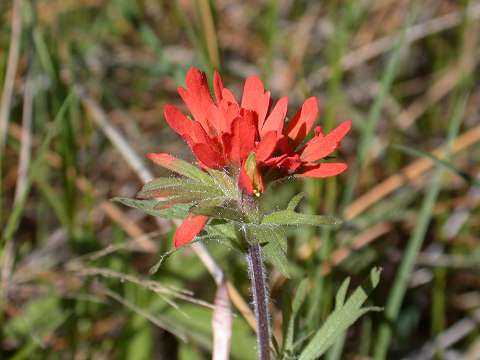

Castilleja coccinea - (image 1 of 9)
Taxonomy
Family: Scrophulariaceae
Habitat
Prairies, sand prairies, calcareous sand flats.
Associates
Andropogon scoparius, Comandra umbellata, Euphorbia corollata, Fragaria virginiana, Hypoxis hirsuta, Lithospermum canescens, Phlox pilosa, Pycnanthemum virginiana, Zizia aurea. In sand prairies with Aletris farinosa, Aster azureus, Heuchera richardsonii, Pedicularis canadensis. In calcareous sand flats with Agalinis purpurea, Gentiana crinita, Hypericum kalmianum, Parnassia glauca, Potentilla fruticosa, Sabatia angularis.
Distribution
MA to Ontario and Manitoba, south to SC, MS, and OK.
Morphology
Annual or biennial to 60 cm. Stems more or less hairy, usually simple. Leaves range from entire to deeply 3 to 5-cleft, with linear or oblong segments; terminal segment usually largest. Flowers in dense spikes 4-6 cm long, elongating to 10-20 cm at maturity; flowers greenish-red to bright red but mostly inconspicuous, subtended by showy yellow or bright red bracts commonly deeply 3-lobed or occasionally 5-lobed.
Notes
Flowers mid April to early September
Wetland indicator: Facultative
A very showy species that is semi-parasitic on grasses. The red form is best known but the yellow form can be quite common. There are over 150 species of Castilleja and most occur in western North American. This one and C. septentrionalis Lindl. are the only two that occur east of IL.
References
Gleason, Henry A. and A. Cronquist. 1991. Manual of Vascular Plants of Northeastern United States and Adjacent Canada. Second Ed.
The New York Botanical Garden. Bronx, NY
Swink, F. and G. Wilhelm. 1994. Plants of the Chicago Region.
Indiana Academy of Science. The Morton Arboretum. Lisle, Illinois.
|
© Michael Hough 2004 |